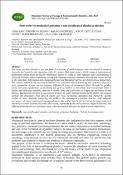Options
Short review on mechanical activation in non-metallurgical alumina production
ISSN
2668-8530
Date issued
2022-12-28
Author(s)
DOI
10.21698/rjeec.2022.206
Abstract
The terms mechano-chemistry and mechanical activation of solid materials were introduced in chemical literature by Ostwald at the beginning of the XX century. Both terms cover a whole range of interconnected phenomena taking place during the mechanical action on solids or their separate parts participating in chemical reactions, phase transitions, mixing and creating composite materials, alloying and crystal growth
in the solid state, deformation and changing physical and thermal properties, all of them at low temperature. The common effects of the mechanical activation on solid material are fracturing and reduction of particle sizes, generation of new reactive surfaces, diffusion of atoms of the reactant phase through the product phase, and quite significantly, accumulating energy in crystalline or amorphous structure (enough twists in
atomic and molecular networks, tensions in atomic bond and active sites to trigger the nucleation of new phases). Mechanical activation is very used to produce all clean alumina mineralogical phases with uniform particle size dimensions from nano to macro size. Also, mechanical activation may extend the specific surface of some minerals, enhancing the yields in the solid-liquid extraction process. With adequate precursors, all phase transitions from amorphous to alfa α-Al2O3 can be carried out on the same route as in thermally activated alumina, but some other routes, impossible by thermal activation, might be followed. The difference between the two activation ways is that mechanical activation is made at room temperature.
in the solid state, deformation and changing physical and thermal properties, all of them at low temperature. The common effects of the mechanical activation on solid material are fracturing and reduction of particle sizes, generation of new reactive surfaces, diffusion of atoms of the reactant phase through the product phase, and quite significantly, accumulating energy in crystalline or amorphous structure (enough twists in
atomic and molecular networks, tensions in atomic bond and active sites to trigger the nucleation of new phases). Mechanical activation is very used to produce all clean alumina mineralogical phases with uniform particle size dimensions from nano to macro size. Also, mechanical activation may extend the specific surface of some minerals, enhancing the yields in the solid-liquid extraction process. With adequate precursors, all phase transitions from amorphous to alfa α-Al2O3 can be carried out on the same route as in thermally activated alumina, but some other routes, impossible by thermal activation, might be followed. The difference between the two activation ways is that mechanical activation is made at room temperature.
Files
Loading...
Name
Articol 06.pdf
Description
Article
Size
525.2 KB
Format
Adobe PDF
Checksum
(MD5):5bea34180b59cb53cf4a96e7df8b49ea